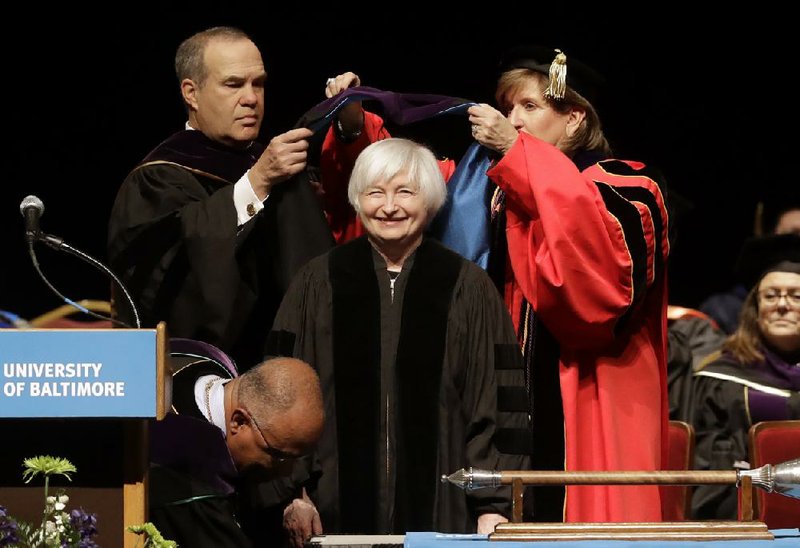WASHINGTON -- Federal Reserve Chairman Janet Yellen and the Fed can finally expect some help from Washington in 2017, after three years of work to juice up a slow economy.
Tax cuts and infrastructure spending planned by President-elect Donald Trump, if backed by the Republican-controlled Congress, would lighten the load for a Fed whose easy-money policies have been the primary economic support for the nation.
Yellen already is breathing easier on the Fed's employment mandate; the unemployment rate has fallen to a nine-year low of 4.6 percent. Inflation, too, is under control and, by all accounts, creeping toward the central bank's optimal level of 2 percent.
And yet, Yellen may come under as much economic and political pressure as ever, on both the Fed's policy and the independence of the institution.
The Trump administration is almost certain to push back as she and her colleagues lift interest rates from historical lows. The Fed began with a small increase in its benchmark rate this month, only the second rise in more than a decade. But officials signaled a quickening of rate increases in 2017.
As a presidential candidate, Trump offered contradictory views when it came to the Fed. He first applauded Yellen, saying he too was a "low-interest-rate person." Later he accused the Fed leader of keeping rates low for political reasons and said he most likely would replace Yellen when her four-year term expires in early 2018. Trump's nominee for Treasury secretary, Steven Mnuchin, said after his selection that he thinks Yellen has done a good job.
No one knows for sure where Trump and his economic team stand on monetary policy. The New York real estate developer, who has capitalized on cheap rates, didn't comment or tweet about the Fed's widely expected rate bump on Dec. 14. But if history is any guide, he's not likely to favor faster interest rate increases.
"No president ever does," said Alice Rivlin, a former Fed vice chairman from 1996 to 1999.
That's because higher interest rates increase borrowing costs for businesses and consumers, which tends to slow lending and investments. The interest-sensitive housing market will be particularly vulnerable. The 10-year bond yield, a benchmark for mortgages, already has jumped to 2.6 percent from 1.8 percent in early November on expectations that a major fiscal stimulus would lift economic growth and inflation.
Fed policymakers have forecast the equivalent of three quarter-point rate increases for next year, but some economists see four or more increases coming. And while Yellen has been cautious to reserve judgment on any anticipated fiscal stimulus, she seemed somewhat cool to the idea when asked at a news conference immediately after the Fed's rate increase announcement.
"I do want to make clear that I have not recommended running a hot economy as some sort of experiment," she said.
Like other economists, Yellen may be questioning whether this is the right time for a huge fiscal stimulus. Given that the economy is at or near full employment -- the point at which much faster growth could spur inflation -- Yellen will be watching carefully and could "take away the punch bowl just as the party gets going," as the famous saying goes on the Fed's job to keep the economy from overheating.
Joseph Gagnon, a former Fed economist and a fellow at the Peterson Institute for International Economics, said he couldn't recall a period when there was a large fiscal injection at a time the economy was at full employment. The last big stimulus package, about $800 billion of federal spending and tax cuts, was passed at the start of President Barack Obama's first term in early 2009 to counteract the recession brought on by the banking collapse.
"The opportunity for fiscal stimulus in doing good is gone," Gagnon said. He argued that if anything, it would cause the Fed only to raise rates faster. With more money chasing higher rates in the U.S., he said, that would push up the dollar, which in turn would hurt the housing market and Trump's effort to correct the nation's trade imbalance.
As former Fed officials and historians know, White House staff members in the past, for example in the Nixon administration, leaned on the Fed to back off raising rates and keep the money supply flowing. Even so, most economists don't think that Trump should be worried about Yellen taking away the punch bowl.
For one thing, even if the Fed raised rates four times next year, the so-called federal funds rate would still probably end 2017 at 1.5 percent to 1.75 percent -- well below normal for the benchmark overnight lending level.
"Yellen's largely off the hook for being a spoiler next year. She won't be able to raise rates far enough to make a difference," said Chris Rupkey, managing director at Mitsubishi UFG Financial Group in New York.
Rather than from the Fed, the Trump administration is more likely to face constraints from financial markets as investors react to prospects of faster economic growth and inflation, said Lynn Reaser, chief economist for Point Loma Nazarene University in San Diego.
"The challenge to fiscal policy, interest rates and the dollar -- those are not being led by the Fed but by the markets," she said.
Business on 12/29/2016

